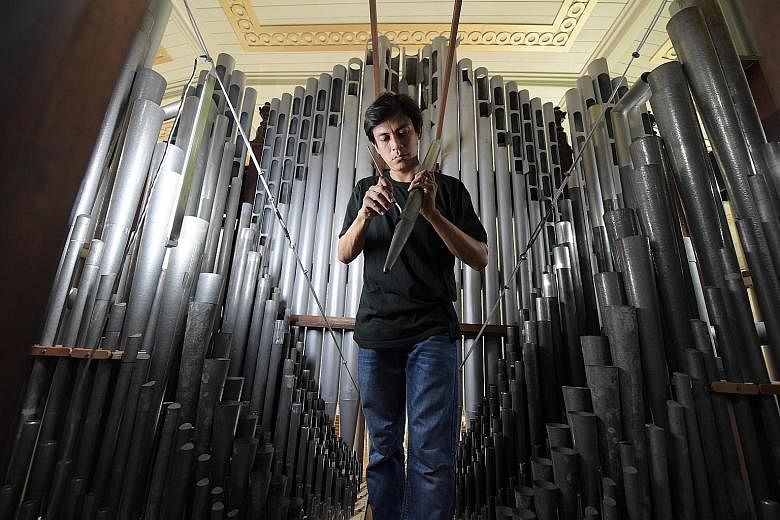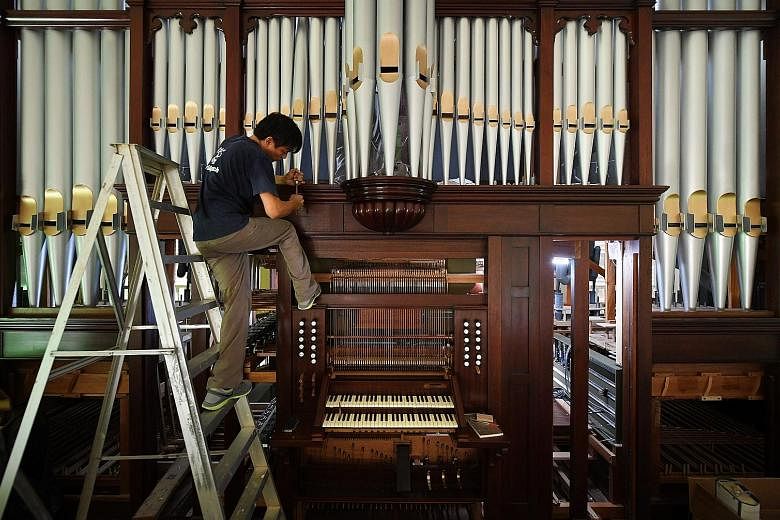For the past few months, strange sounds have issued late at night from a church in Bras Basah Road.
A crew was slogging away in the second-storey gallery at the back of the church, blowing air through pipes of metal and wood. They were reassembling - mostly by hand - the five-tonne, 1,800-pipe organ in the Roman Catholic Cathedral of the Good Shepherd.
The instrument was completely taken apart during the three-year restoration of the 173-year-old cathedral, which was completed last November. Now, the 105-year-old organ - the oldest among the 10 or so in Singapore - can again be heard in its full glory.
On Wednesday, after the last screw was tightened and the last pipe tuned, the keys were handed over to cathedral organist Alphonsus Chern.
Mr Chern, 36, said it will be played almost every day. The cathedral holds daily services, including four masses on weekends.
A well-built pipe organ is a durable machine meant to be played frequently to keep all the parts moving smoothly, said Mr Cealwyn Tagle, 45, an organ builder from Philippine company Diego Cera, which oversaw the restoration.
Originally made by British firm Bevington and Sons in 1912, the organ's condition had deteriorated by the 1980s.
Mr Robert Navaratnam, the only organ builder in Singapore at the time, made repairs and expanded its range, adding old pipes he salvaged from elsewhere in Singapore and abroad.
His efforts transformed it into an instrument that visiting British organist David Price said in 2012 had a "very fine sound" in the reverberant acoustics of the cathedral.
The organ has many different kinds of pipes, and a critical task in rebuilding it was to make them blend well with one another, in a painstaking process known as voicing. "If the pipe sounds freely, that's the best thing," said Mr Tagle, who was trained in Germany and Austria.
He added: "The original pipes were well designed and needed only minor adjustments."
As with most organs, the cathedral's has two main types of pipes - flues and reeds. They are linked to multiple keyboards, played by hands and feet, through mechanical levers that open valves which let in air through the bottom of the pipes, producing sound.
The flue pipes work like the plastic recorders played in school, while the reeds are like the paper trumpets in party packs, producing a louder and more nasal sound.
The pipes are usually made of wood or an alloy of tin and lead, and endless variations in sound quality can be obtained by changing their dimensions and material.
Mr Chern worked closely with the builders. He recalled that they would begin work after dinner every night, continuing until 3am.
"We needed it (the church) to be absolutely silent," said Mr Chern. "I would help him press the keys, and would shout out: 'It's too bright, it's too loud, it's too dull.'"
Mr Tagle adjusted various parts of each pipe by carefully tapping the metal parts or shaving off tiny bits of wood until it "spoke" with the correct sound.
The completion of the cathedral organ is just the beginning of Diego Cera's work here. The firm is now setting up an office in Singapore to coordinate projects in Asia that are outside the Philippines.
The cathedral management is pitching in, with a new scholarship programme started last month to nurture organists. It is supported by an anonymous non-Catholic donor, who has pledged the $30,000 needed each year to run it.
There are probably fewer than 100 people in Singapore who are trained to play traditional pipe organs, said Dr Evelyn Lim, dean of the Singapore chapter of the American Guild of Organists, who has taken the cathedral's first four organ scholars under her wing.
Mr Andre Ahchak, spokesman for the Roman Catholic Archdiocese of Singapore, said of the organ's appeal: "It is the purity and grandeur of the sound.
"To explain this is impossible - you have to hear it."



